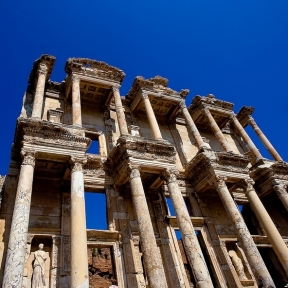I, John, your brother and partner in the tribulation and the kingdom and the patient endurance that are in Jesus, was on the island called Patmos on account of the word of God and the testimony of Jesus. I was in the Spirit on the Lord’s day, and I heard behind me a loud voice like a trumpet saying, Write what you see in a book and send it to the seven churches, to Ephesus and to Smyrna and to Pergamum and to Thyatira and to Sardis and to Philadelphia and to Laodicea. Then I turned to see the voice that was speaking to me, and on turning I saw seven golden lampstands, and in the midst of the lampstands one like a son of man, clothed with a long robe and with a golden sash around his chest. The hairs of his head were white, like white wool, like snow. His eyes were like a flame of fire, his feet were like burnished bronze, refined in a furnace, and his voice was like the roar of many waters. In his right hand he held seven stars, from his mouth came a sharp two-edged sword, and his face was like the sun shining in full strength. When I saw him, I fell at his feet as though dead. But he laid his right hand on me, saying, Fear not, I am the first and the last, and the living one. I died, and behold I am alive forevermore, and I have the keys of Death and Hades. Write therefore the things that you have seen, those that are and those that are to take place after this. As for the mystery of the seven stars that you saw in my right hand, and the seven golden lampstands, the seven stars are the angels of the seven churches, and the seven lampstands are the seven churches. [Revelation 1:9-20]
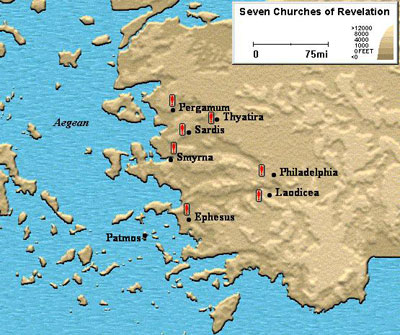
In Revelation chapter two John writes seven letters to seven churches of Asia Minor, present-day Turkey. John was instructed to, “write the things that you have seen, those that are, and those that are to take place after this.” Although these letters had relevant messages for these seven churches in John’s time (those that are), they are also messages to seven distinct generations of the church (those that are to take place after this).
The Churches in Asia. - There were more churches in Asia than seven. We may confine ourselves to that western fraction of Asia known as Asia Minor, or we may include still less territory than that; for in even that small portion of Asia Minor where were situated the seven churches which are mentioned, and right in their very midst, there were other important churches. Colosse, to the Christians of which place Paul addressed his epistle to the Colossians, was but a slight distance from Laodicea. Miletus was nearer than any of the seven to Patmos, where John had his vision; and it was an important station for the church, as we may judge from the fact that Paul, during one of his stays there, sent for the elders of the church of Ephesus to meet him at that place. Acts20:17-38. At the same place he also left, in good Christian hands no doubt, Trophimus, his disciple, sick. 2Tim.4:20. And Troas, where Paul spent a season with the disciples, and whence, having waited till the Sabbath was past, he started off upon his journey, was not far removed from Pergamos, named among the seven. It becomes, therefore, an interesting question to determine why seven of the churches of Asia Minor were selected as the ones to which the Revelation should be dedicated. Does what is said of the seven churches in chapter 1, and to them in chapters 2 and 3, have reference solely to the seven literal churches named, describing things only as they then and there existed, and portraying what was before them alone? We cannot so conclude, for the following reasons:
- The entire book of Revelation (see chapter 1:3,11,19; 22:18,19) was dedicated to the seven churches. Verse 11. But the book was no more applicable to them than to other Christians in Asia Minor, - those, for instance, who dwelt in Pontus, Galatia, Cappadocia, and Bithynia, addressed in 1Peter1:1; or the Christians of Colosse, Troas, and Miletus, in the very midst of the churches named.
- Only a small portion of the book could have personally concerned the seven churches, or any of the Christians of John's day; for the events it brings to view were mostly so far in the future as to lie beyond the lifetime of the generation then living, or even the time during which those churches would continue; and consequently they could have no personal connection with them.
- The seven stars which the Son of man held in his right hand (verse 20), are declared to be the angels of the seven churches. The angels of the churches, doubtless all will agree are the ministers of the churches. Their being held in the right hand of the Son of man denotes the upholding power, guidance, and protection vouchsafed to them. But there were only seven of them in his right hand. And are there only seven thus cared for by the great Master of assemblies? May not, rather, all the true ministers of the whole gospel age derive from this representation the consolation of knowing that they are upheld and guided by the right hand of the great Head of the church: Such would seem to be the only consistent conclusion.
- Again, John, looking into the Christian dispensation saw only seven candlesticks, representing seven churches, in the midst of which stood the Son of man. The position of the Son of man in their midst must denote his presence with them, his watchcare over them, and his searching scrutiny of all their works. But does he thus take cognizance of only seven individual churches in this dispensation? May we not rather conclude that this scene represents his position in reference to all his churches during the gospel age? Then why were only seven mentioned? Seven, as used in the Scriptures, is a number denoting fullness and completeness, being, doubtless a kind of memorial of the great facts of the first seven days of time, which gave the world the still used weekly cycle. Like the seven stars, the seven candlesticks must denote the whole of the things which they represent. The whole gospel church in seven divisions, or periods, must be symbolized by them; and hence the seven churches must be applied in the same manner.
- Why, then, were the seven particular churches chosen that are mentioned? For the reason, doubtless, that in the names of these churches, according to the definitions of the words, are brought out the religious features of those periods of the gospel age which they respectively were to represent.
For these reasons, “the seven churches” are doubtless to be understood to mean not merely the seven literal churches of Asia which went by the names mentioned, but seven periods of the Christian church, from the days of the apostles to the close of probation.
It may here be added that this view is neither new nor local. Benson quotes Bishop Newton as saying, “Many contend, and among them such learned men as More and Vitringa, that the seven epistles are prophetical or so many successive periods, or states, of the church, from the beginning to the conclusion of all.” Scott says: “Many expositors have imagined that these epistles to the seven churches were mystical prophecies of seven distinct periods, into which the whole term, from the apostles’ days to the end of the world, would be divided.”
Although Newton and Scott do not themselves hold this view, their testimony is good as showing that such has been the view of many expositors. Matthew Henry says: “An opinion has been held by some commentators of note, which may be given in the words of Vitringa: ‘That under this emblematical representation of the seven churches of Asia, the Holy Spirit has delineated seven different states of the Christian church, which would appear in succession, extending to the coming of our Lord and the consummation of all things: that this is given in descriptions taken from the names, states, and conditions of these churches, so that they might behold themselves, and learn both their good qualities and their defects, and what admonitions and exhortations were suitable for them’ Vitringa has given a summary of the arguments which may be alleged in favor of this interpretation. Some of them are ingenious, but they are not now considered sufficient to support such a theory. Gill is one of the principal of the English commentators who adopt this view, that ’they are prophetical of the churches of Christ in the several periods of time until he appears again.’”
It appears from the authors above cited, that what has led commentators of more modern times to discard the view of the prophetical nature of the messages to the seven churches, is the comparatively recent and unscriptural doctrine of the temporal millennium. The last stage of the church, as described in chapter 3:15-17, was deemed to be incompatible with the glorious state of things which would exist here on this earth for a thousand years, with all the world converted to God. Hence in this case, as in many others, the more Scriptural view is made to yield to the more pleasing. The hearts of men, as in ancient times, still love smooth things, and their ears are ever favorably open to those who will prophesy peace. [Uriah Smith, Daniel and the Revelation]
Ephesus: The First Century Church
To the angel of the church in Ephesus write: The words of him who holds the seven stars in his right hand, who walks among the seven golden lampstands. I know your works, your toil and your patient endurance, and how you cannot bear with those who are evil, but have tested those who call themselves apostles and are not, and found them to be false. I know you are enduring patiently and bearing up for my name’s sake, and you have not grown weary. But I have this against you, that you have abandoned the love you had at first. Remember therefore from where you have fallen; repent, and do the works you did at first. If not, I will come to you and remove your lampstand from its place, unless you repent. Yet this you have: you hate the works of the Nicolaitans, which I also hate. He who has an ear, let him hear what the Spirit says to the churches. To the one who conquers I will grant to eat of the tree of life, which is in the paradise of God. [Revelation 2:2-7]
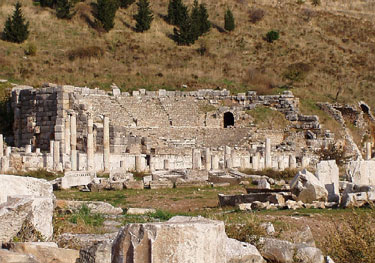
Ephesus was a prominent city - the gateway to Asia Minor. The city was the center for the worship of Diana (Mother of the gods) and in 480 BC the great temple of Diana was erected here as a symbol to the world. Her temple was four times the size of the Parthenon in Athens and was counted among the seven wonders of the ancient world. The temple was destroyed in 263 AD and only the foundation stones remain.
Unto the angel of the church of Ephesus write; These things saith he that holdeth the seven stars in his right hand, who walketh in the midst of the seven golden candlesticks (Revelation 2:1).
Each letter is introduced with a part of the description of Christ in Revelation 1. Here, Jesus walks among the candlesticks demonstrating His abiding presence.
The name Ephesus means “desirable.” There was much that was commendable about the Christian Church here in Ephesus. It had patience and good works, and had tested the false teachers and had remained faithful to the truth. The Ephesian Christians hated the “deeds of the Nicolations,” a group who sought accommodation with the pagan world and discounted obedience to God’s law.
However, by John’s day, before the end of the century, the first stages of disunity were creeping into the Church, provoking the admonishment, “Nevertheless, I have somewhat against thee, because thou has left thy first love” (Revelation 2:4).
The apostle Paul wrote a letter to the church of Ephesus as well. We know this letter as the book of Ephesians and we learn much about this church from his epistle. Paul beseeches the Ephesian Christians to live worthy of their calling to serve God (Ephesians 4:1-2). He explains to them afresh what it means to have put on Christ (Ephesians 4:17-24). His warning to “grieve not the holy Spirit” (Ephesians 4:30) is an indication of the intensity of the battle for the soul.
Paul calls the Ephesians back to unity (Ephesians 4:3-6), and admonishes them not to sin but to walk in love and the light of the Gospel (Ephesians 4:26). These same sentiments are expressed in Revelation’s letter to Ephesus: Remember therefore from whence thou art fallen, and repent, and do the first works; or else I will come unto thee quickly, and will remove thy candlestick out of his place, except thou repent (Revelation 2:5).
Each of the letters to the seven churches ends with an encouragement to overcome and each church is told of a special blessing they will experience in heaven. The church members of Ephesus are given one of the joys that await all of God’s redeemed when they reach heaven: To him that overcometh will I give to eat of the tree of life, which is in the midst of the paradise of God (Revelation 2:7).

The Ephesian church represents the first century after Christ. The Church had grown into a force to be reckoned with, and Christianity was starting to challenge the religions and ideological institutions of the day.
The apostle Paul remained in Ephesus for more than two years on his third major journey, and his preaching led to a major conflict between the Gospel and the worship of Diana. This preaching turned many away from idol worship, upsetting silversmiths who specialized in the manufacture of idols (Acts 19:26).
Satan can’t stand when souls are taken from his sphere of influence. The rapid spread of Christianity in the first century AD served to escalate the conflict between Christianity and paganism and the inevitable consequence was persecution.
The great pagan religions had been set up by Satan to counterfeit the plan of salvation and to deny access to the world’s Redeemer. It has always been Satan’s strategy to either force or deceive people to accept the counterfeit rather than the true.
In Ephesus, Christianity struck a blow to the worship of Diana, the Mother of the gods. It is noteworthy that the modern-day equivalent, the worship of Mary as the mother of God, finds its root in Ephesus. In 451 AD, at the Council of Ephesus, the Roman Catholic Church bequeathed the title “Mother of God” to Mary, thus reviving the ancient cult in a modern garb. [Walter Veith, Walking Through Revelation]
The time covered by this first church may be considered the period from the resurrection of Christ to the close of the first century, or to the death of the last of the apostles. [Uriah Smith, Daniel and the Revelation]
Smyrna: The Church in Tribulation
And to the angel of the church in Smyrna write: The words of the first and the last, who died and came to life. I know your tribulation and your poverty (but you are rich) and the slander of those who say that they are Jews and are not, but are a synagogue of Satan. Do not fear what you are about to suffer. Behold, the devil is about to throw some of you into prison, that you may be tested, and for ten days you will have tribulation. Be faithful unto death, and I will give you the crown of life. He who has an ear, let him hear what the Spirit says to the churches. The one who conquers will not be hurt by the second death. [Revelation 2:8-11]
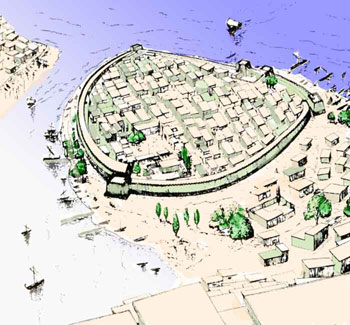
Smyrna was situated 60 kilometers north of Ephesus at the present-day port of Izmer, which today is Turkey’s second largest city with one of the most important harbors in the region.
Smyrna housed the shrine to the goddess Nemesis and was one of the last cities to fall to Islam.
Acts 19:10 suggests that the church in Smyrna may have been established by Paul on his third missionary journey.
The letter to Smyrna contains no admonishment, and as the name implies, the sacrifice which Christians were called upon to make in this time period served to draw people to Christ (see 2 Corinthians 2:14-15).
To this church, many of whose members would actually suffer death by persecution, Jesus introduced Himself as “the first and the last, which was dead, and is alive” (Revelation 2:8). Then the words of the coming peril were given, “Fear none of those things which thou shalt suffer: behold, the devil shall cast some of you into prison, that ye may be tried; and ye shall have tribulation ten days” (Revelation 2:10).
These words were fulfilled, for during this period, the most vicious persecutions occurred against the Christians. In 107 AD, Ignatius, Bishop of Antioch in Syria and a friend of John the apostle, was thrown to the lions and eaten alive in the amphitheatre of Rome.
In 155 AD, Polycarp, bishop of Smyrna and a close friend of Ignatius, was killed by the sword, his body burned at the stake in Smyrna.
It was through the witness of Christian martyrs that Tertullian of Carthage, in Africa, was converted to Christianity at the age of 30, and thereafter became a defender of the Christian faith.
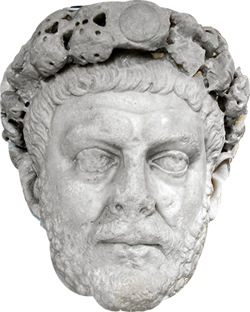
This period of persecution came to its climax under Diocletian, who, in 303 AD, launched a vicious, empire-wide effort for the complete annihilation of Christianity. Although he died in 305 AD, the persecution continued until it was finally brought to an end in 313 AD by the decree of toleration issued by Emperor Constantine.
The Diocletian persecution lasted ten years. The ten-day tribulation predicted for this church (verse 10) coincides with this ten-year period when the day-year principle of Biblical prophecy is applied. Persecution cleansed the Church by forcing Christians to consider whether they were truly willing to follow Christ in all circumstances.
In the ancient city of Smyrna, the most expensive homes were on the mountainsides that rose above the bay. This gave it the name “Crown City.” We can appreciate the appropriateness of the promise, “be thou faithful unto death, and I will give thee a crown of life … He that overcometh shall not be hurt of the second death.” (Revelation 2:10-11). [Walter Veith, Walking Through Revelation]
Pergamum: The Church Elevated
And to the angel of the church in Pergamum write the words of him who has the sharp two-edged sword. I know where you dwell, where Satan’s throne is. Yet you hold fast my name, and you did not deny my faith even in the days of Antipas my faithful witness, who was killed among you, where Satan dwells. But I have a few things against you: you have some there who hold the teaching of Balaam, who taught Balak to put a stumbling block before the sons of Israel, so that they might eat food sacrificed to idols and practice sexual immorality. So also you have some who hold the teaching of the Nicolaitans. Therefore repent. If not, I will come to you soon and war against them with the sword of my mouth. He who has an ear, let him hear what the Spirit says to the churches. To the one who conquers I will give some of the hidden manna, and I will give him a white stone, with a new name written on the stone that no one knows except the one who receives it. [Revelation 2:12-17]
Against the church of Smyrna, which has just been considered, there was no word of condemnation uttered. Persecution is ever calculated to keep the church pure, and incite its members to piety and godliness. But we now reach a period when influences began to work through which errors and evils were likely to creep into the church. The word Pergamos signifies height, elevation. The period covered by this church may be located from the days of Constantine, or perhaps, rather, from his professed conversion to Christianity, A.D.323, to the establishment of the papacy, A.D.538. It was a period in which the true servants of God had to struggle against a spirit of worldly policy, pride, and popularity among the professed followers of Christ, and against the virulent workings of the mystery of iniquity, which finally resulted in the full development of the papal man of sin. [Uriah Smith, Daniel and the Revelation]
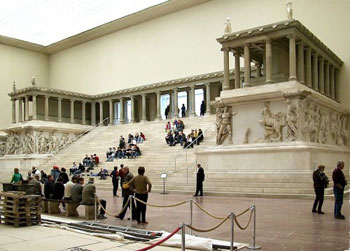
Pergamos (also called Pergamon or Pergamum) was situated 60 kilometres past Smyrna along the ancient Roman postal road. The name means “elevation” or “exalted.” Appropriately, the religious and cultural center of the city was on top of a conspicuous mount.
Pergamos inherited the ancient system of sun worship from Babylon. According to Revelation 2:13, Pergamos was Satan’s seat. It was a center of ancient sun worship, and the place where the famous altar of Zeus stood on a terrace on the slopes of the mount.
The leader of Pergamos used the same ancient title and vestments as Babylonian priests. The last pontiff king of Pergamos was Attalus III, who bequeathed his title to Rome in 133 BC, which “ended the history of Pergamum as an independent political entity.”
Today, the city of Bergama lies at the base of the mountain on which Pergamos once sat. Excavations nearby have uncovered a vast complex which included two temples, a theater, and a medical library. Some of the most famous physicians practiced here. The medical symbol was a serpent wrapped around a pole - very similar to the symbol representing medicine today. Nearby stood the world’s second largest library (after Alexandria), with a collection of some 200,000 volumes.
When persecution could not rid the earth of Christianity, the great adversary turned to deception and compromise to rid the world of its influence.
The letter rebuked the church of Pergamos for fraternizing with those who held the doctrines of Balaam and the Nicolaitans. It was Balaam who led Israel to moral corruption, just before they were due to cross over the Jordan into the Promised Land. The Nicolaitans, a heretical sect who compromised with the pagan cults, had been rejected by the Ephesian church but were courted by the church of Pergamos.
The Pergamos period began in 313 AD and continued until 538 AD.
This was a period of deteriorating moral standards and doctrinal corruption. Satan had failed to destroy the Church through persecution so instead he endeavoured to destroy her through compromise. Christian standards were lowered, and a union was formed between Christianity and paganism.
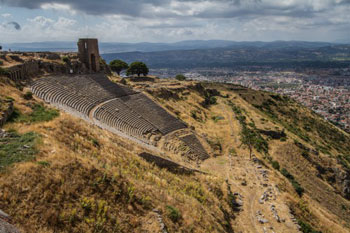
It was during the Pergamos period that the Church adopted many pagan practices. The seeds of paganism had already been sown into Rome when King Attalus III had bequeathed his title Pontifex Maximus to the pagan Roman emperors in 133 BC.
In 322 Emperor Constantine converted to Christianity, but kept the pagan title Pontifex Maximus. In his efforts to unite his empire in the early 300s, Emperor Constantine blended the interests of pagans and Christians. Concerning Constantine’s aims, Church historian F.J. Foakes-Jackson declares, “In dealing with the Church, his object was gradually to transfer from heathenism to Christianity all that had hitherto made it attractive in the eyes of the people.”
However, in 378 AD, Emperor Gratian refused the title Pontifex Maximusas unbefitting for a Christian. The Roman Catholic bishop then took the title upon himself, as the Catholic Church has done with many pagan sun worship symbols. The church in Pergamos represents this historical period of compromise. In exchange for religious tolerance and acceptance, the true principles of Christianity were sacrificed to accommodate pagan beliefs.
By the end of the period, in 538 AD, Emperor Justinian decreed Christianity the official religion of the empire, joining church and state.
In spite of this drift from the true faith of the early apostles, there were those who sought to maintain the true faith. Foremost among them was Patrick, who, in the early years of the fifth century, established scores of churches out of which grew the Celtic Church. This church held onto much of the true faith through the centuries of spiritual darkness that followed.
The promise to the faithful of the Pergamos period was, “To him that overcometh will I give to eat of the hidden manna, and will give him a white stone, and in the stone a new name written, which no man knoweth saving he that receiveth it” (Revelation 2:17). [Walter Veith, Walking Through Revelation]
The Promise. - To the overcomer it is promised that he shall eat of the hidden manna, and receive from his approving Lord a white stone, with a new and precious name engraved thereon. Concerning manna that is “hidden,” and a new name that no one is to know but he that receives it, not much in the way of exposition should be required. But there has been much conjecture upon these points, and an allusion to them may be expected. Most commentators apply the manna, white stone, and new name, to spiritual blessings to be enjoyed in this life; but like all the other promises to the overcomer, this one doubtless refers wholly to the future, and is to be given when the time comes that the saints are to be rewarded. Perhaps the following from the late H. Blunt is as satisfactory as anything that has ever been written upon these several particulars:
“It is generally thought by commentators that this refers to an ancient judicial custom of dropping a black stone into an urn when it is intended to condemn, and a white stone when the prisoner is to be acquitted; but this is an act so distinct from that described, ‘I will give thee a white stone,’ that we are disposed to agree with those who think it refers rather to a custom of a very different kind, and not unknown to the classical reader, according with beautiful propriety to the case before us. In primitive times, when traveling was rendered difficult from want of places of public entertainment, hospitality was exercised by private individuals to a very great extent of which, indeed, we find frequent traces in all history, and in none more than the Old Testament. Persons who partook of this hospitality, and those who practiced it, frequently contracted habits of friendship and regard for each other, and it became a well-established custom among the Greeks and Romans to provide their guests with some particular mark, which was handed down from father to son, and insured hospitality and kind treatment whenever it was presented. This mark was usually a small stone or pebble, cut in half, upon the halves of which the host and guest mutually inscribed their names, and then interchanged with each other. The production of this tessera was quite sufficient to insure friendship for themselves or descendants whenever they traveled again in the same direction, while it is evident that these stones required to be privately kept, and the names written upon them carefully concealed, lest others should obtain the privileges instead of the persons for whom they were intended.”
“How natural, then, the allusion to this custom in the words of the text, ‘I will give him to eat of the hidden manna!’ and having done this, having made him partake of my hospitality, having recognized him as my guest and friend, I will present him with the white stone, and in the stone a new name written, which no man knoweth save he who receiveth it. I will give him a pledge of my friendship, sacred and inviolable, known only to himself.”
On the new name, Wesley very appropriately says: “Jacob, after his victory, gained the new name of Israel. Wouldst thou know what thy new name will be? The way to this is plain - overcome. Till then, all thy inquiries are vain. Thou wilt then read it on the white stone.” [Uriah Smith, Daniel and the Revelation]
Thyatira: The Middle Ages
And unto the angel of the church in Thyatira write; These things saith the Son of God, who hath his eyes like unto a flame of fire, and his feet are like fine brass; I know thy works, and charity, and service, and faith, and thy patience, and thy works; and the last to be more than the first. Notwithstanding I have a few things against thee, because thou sufferest that woman Jezebel, which calleth herself a prophetess, to teach and to seduce my servants to commit fornication, and to eat things sacrificed unto idols. And I gave her space to repent of her fornication; and she repented not. Behold, I will cast her into a bed, and them that commit adultery with her into great tribulation, except they repent of their deeds. And I will kill her children with death; and all the churches shall know that I am he which searcheth the reins and hearts: and I will give unto every one of you according to your works. But unto you I say, and unto the rest in Thyatira, as many as have not this doctrine, and which have not known the depths of Satan, as they speak; I will put upon you none other burden. But that which ye have already hold fast till I come. And he that overcometh, and keepeth my works unto the end, to him will I give power over the nations: And he shall rule them with a rod of iron; as the vessels of a potter shall they be broken to shivers: even as I received of my Father. And I will give him the morning star. He that hath an ear, let him hear what the Spirit saith unto the churches. [Revelation 2:18-29]
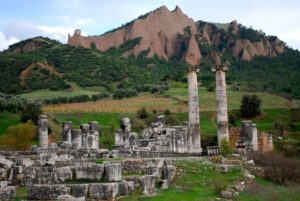
Thirty kilometers west of Pergamos on the imperial Roman road lay Thyatira, where the town of Akhisar lies today. Apollo, the sun god, was the chief deity of the city. The city was also noted for its industries, the most notable being the dying of cloth - particularly in the colors purple and crimson.
The church of Thyatira represents the Church of the Middle Ages. Thyatira received the longest of the letters, containing grave information about the conditions that would prevail. The Church would be inundated with false doctrines and persecuted for faithfulness to God and His Word.
The spirit of compromise that started with Pergamos would reach its zenith in the time of Thyatira. As the name “sweet savour of labor” implies, works as a means to obtaining grace would become a prominent feature of the time. The introductory statement in the letter to Thyatira highlights this point: I know your works, love, service, faith, and your patience; and as for your works, the last are more than the first (Revelation 2:19 NKJV).
In this time of spiritual darkness, the truth was abandoned and Christianity was replaced by the old pagan form of sun worship dressed in a garb of Christianity. Forms, rituals, objects, and works replaced the elevating truths of the Gospel. Pagan deities masquerading under Gospel titles replaced Jesus, and the ancient Babylonian mysteries were reintroduced.

Even the pagan vestments with their prominent purple and crimson colors were introduced as the vestments of the priesthood. The symbols of Dagon, the fish god, became symbols of the so-called “shepherds of the flock.”
The promise of the ultimate victory of Christ stands as a rebuke to the Church of the Middle Ages: And he that overcometh, and keepeth my works unto the end, to him will I give power over the nations: And he shall rule them with a rod of iron (Revelation 2:26-27).
The letter to Thyatira contains a strong rebuke: Notwithstanding, I have a few things against thee, because thou sufferest that woman Jezebel, which calleth herself a prophetess, to teach and seduce my servants to commit fornication, and to eat things sacrificed unto idols. (Revelation 2:20)
Ahab, king of Israel, had married Jezebel, a Phonecian Baal worshiper, although God had expressly forbidden intermarriage with heathens. This marriage led to Baal worship being introduced into Israel, even though it was supposedly done in the name of Jehovah.
So it was in the prophetic time of Thyatira. Pagan temples, symbols, and festivals were converted into Christian temples, symbols, and religious festivals. All this was done in the name of true worship of the divine God.
Speaking of this amalgamation, Arthur E.R. Boak declares this:
The long association between pagans and Christians and the rapid incorporation of new converts into the ranks of the Church (after Constantine’s “conversion”), exercised a profound influence upon Christian beliefs and practices. Pagan belief in magic contributed largely to the Christian belief in miracles; and the development of the cult of the saints was stimulated by pagan concepts of inferior divinities, demigods and demons. Many pagan festivals were transferred into the festivals of the Church. [Walter Veith, Walking Through Revelation]
Sardis: The Church in Reform
And unto the angel of the church in Sardis write; These things saith he that hath the seven Spirits of God, and the seven stars; I know thy works, that thou hast a name that thou livest, and art dead. Be watchful, and strengthen the things which remain, that are ready to die: for I have not found thy works perfect before God. Remember therefore how thou hast received and heard, and hold fast, and repent. If therefore thou shalt not watch, I will come on thee as a thief, and thou shalt not know what hour I will come upon thee. Thou hast a few names even in Sardis which have not defiled their garments; and they shall walk with me in white: for they are worthy. He that overcometh, the same shall be clothed in white raiment; and I will not blot out his name out of the book of life, but I will confess his name before my Father, and before his angels. He that hath an ear, let him hear what the Spirit saith unto the churches. [Revelation 3:1-6]
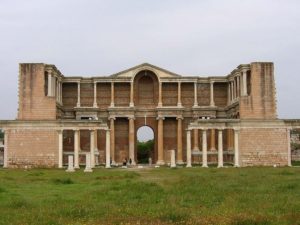
Sardis (today called Sart) was the capital of the province of Lydia, situated some 40 kilometers southwest of Thyatira. The city stood on a hill, and at the foot of that hill were the temples of Artemis and Zeus.
In view of Sardis’ location and natural protections, the people of Sardis considered the city impregnable. They felt so secure that their guard was not always up in time of crisis. History reveals that the city was conquered without resistance by both Cyrus and Antiochus, and in this lies a spiritual lesson. In its opening address, the letter to Sardis says, “I know thy works, that thou hast a name that thou livest, and art dead” (Revelation 3:1).
This mention of death takes us into the post-Reformation period, from the close of the Council of Trent in 1563, to the beginning of the great religious awakening in the 18th century. This period has been fittingly described as “the age of dead orthodoxy.” Instead of the reformers continuing their work of restoration, they submitted to the protection and support of the civil authorities. While separating from Rome, the Protestant Church became subject to the state.
The Reformation was rooted in Christ. It is the Gospel of Christ that led the reformers out of the spiritual darkness that had all but extinguished the flame of Christianity. Sadly, this early fervor was gradually replaced by formalities as the community and the state accepted the new churches.
The inability of the various reform factions to find unity based on the Word also led to the formation of numerous denominations, each adopting the creed of its founders. The great work of reform faltered and even resulted in bitter infighting.
Added to this, the Counter Reformation launched by the Roman Catholic Church gradually eroded faith in the Scriptures and even set the tone for tolerance and acceptance of the teachings of Rome. The Church of Sardis was given this warning:
Be watchful, and strengthen the things which remain, that are ready to die: for I have not found thy works perfect before God. Remember therefore how thou hast received and heard, and hold fast, and repent. If therefore thou shalt not watch, I will come on thee as a thief, and thou shalt not know what hour I will come upon thee (Revelation 3:2-3).
The Reformation had failed to fortify itself against complacency and became the easy prey of those who wished to destroy it. In the midst of persecution, many courageous reformers were willing to lay down their lives rather than to deny Christ. It is to these that Christ says, “Thou hast a few names even in Sardis which have not defiled their garments; and they shall walk with me in white: for they are worthy” (Revelation 3:4).
The message to Sardis is a message calling believers back to the truth and to steadfastness in faith:
He that overcometh, the same shall be clothed in white raiment; and I will not blot out his name out of the book of life, but I will confess his name before my Father, and before his angels (Revelation 3:5). [Walter Veith, Walking Through Revelation]
Philadelphia: The Church Revival
And to the angel of the church in Philadelphia write; These things saith he that is holy, he that is true, he that hath the key of David, he that openeth, and no man shutteth; and shutteth, and no man openeth; I know thy works: behold, I have set before thee an open door, and no man can shut it: for thou hast a little strength, and hast kept my word, and hast not denied my name. Behold, I will make them of the synagogue of Satan, which say they are Jews, and are not, but do lie; behold, I will make them to come and worship before thy feet, and to know that I have loved thee. Because thou hast kept the word of my patience, I also will keep thee from the hour of temptation, which shall come upon all the world, to try them that dwell upon the earth. Behold, I come quickly: hold that fast which thou hast, that no man take thy crown. Him that overcometh will I make a pillar in the temple of my God, and he shall go no more out: and I will write upon him the name of my God, and the name of the city of my God, which is new Jerusalem, which cometh down out of heaven from my God: and I will write upon him my new name. He that hath an ear, let him hear what the Spirit saith unto the churches. [Revelation 3:7-13]
Philadelphia lies 45 kilometers east of Sardis and today the city of Alashehir stands where the ancient city stood. Philadelphia was situated at the foot of the mountains leading to Annatolia and, as such, was the doorway to this region.
And to the angel of the church in Philadelphia write; These things saith he that is holy, he that is true, he that hath the key of David, he that openeth, and no man shutteth; and shutteth, and no man openeth (Revelation 3:7).
The letter to Philadelphia contains no reproof. The time period it represents was to open the door to the Gospel so that it could be spread to the ends of the world. The Word of God was to be restored and truth would triumph.
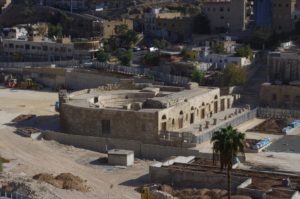
Philadelphia means “brotherly love.” The Philadelphia period is the period of the Great Awakening of the 18th century. It is the period of mission. The words of commendation were, “I know thy works: behold, I have set before thee an open door, and no man can shut it: for thou hast a little strength, and hast kept my word, and hast not denied my name” (Revelation 3:8).
During the Philadelphian era, the great conflict between truth and terror reached its pinnacle. The Millerite movement reaffirmed the truth of the Word and its prophetic importance, and the era of world mission began.
William Carey became the messenger to India in 1793, and Robert Morrison to China in 1807. In 1817, Robert Moffat carried the message to Africa and John Wesley challenged the doctrines of Calvin. Between 1804 and 1834, numerous Bible societies were established, and the door for the Gospel was opened.
As always in an age of spiritual enlightenment, Satan endeavored to destroy the work by the introduction of counterfeit movements. Spiritism in all its forms saw its modern revival at that time. Out of the French Revolution of 1789-1799 came the concepts of humanism and atheism that were to form the foundation stones for communism. The period also saw the rise of many false prophets who would claim special revelations contrary to the Word of God.
The Great Awakening of this time was met with suspicion and even hostility by the established churches of the day as they refused to accept new light on the Scriptures. The age of Philadelphia was an age of brotherly love among those who embraced the truths of the Second Coming of Christ, but they were derided and mocked for their stance.
Behold, I will make them of the synagogue of Satan, which say they are Jews, and are not, but do lie; behold, I will make them to come and worship before thy feet, and to know that I have loved thee. Because thou hast kept the word of my patience, I also will keep thee from the hour of temptation, which shall come upon all the world, to try them that dwell upon the earth (Revelation 3:9-10).
The word Jews used here is a reference to Jewish Christians (see Romans 2:28-29; Galatians 3:28-29). The Jew referred to here represents those Christians who would reject the light and ridicule those who believed it.
The promise is also given that the Philadelphian era would not be subjected to the time of trouble prophesied by Daniel that was to precede the coming of Christ. The promise of Christ’s soon return given in verse 11 (“Behold I come quickly”) is further evidence of the historic continuous nature of the prophetic content of the letters to the seven churches.
To the Church of the Middle Ages (Thyatira) the message was given to “hold fast what you have till I come” (Revelation 2:25), whereas in Philadelphia the Church is given the same admonition but this time in reference to His soon return. The Great Disappointment came as a major blow to many in the Advent movement and the counsel to “Hold fast what you have that no one may take your crown” (Revelation 3:11) is appropriate to this era.
“Not I, but Christ” was the watchword of the Philadelphian Christians, and the same motto should be for all of Christ’s followers. Once we lay our selves down in humility, Christ and His love can conquer through us. The Word-based unity and love-based community of the Church of Philadelphia is a shining example of what all who aspire to follow Christ should seek to acquire. [Walter Veith, Walking Through Revelation]
Laodicea: Today’s Church
And unto the angel of the church of the Laodiceans write; These things saith the Amen, the faithful and true witness, the beginning of the creation of God; I know thy works, that thou art neither cold nor hot: I would thou wert cold or hot. So then because thou art lukewarm, and neither cold nor hot, I will spue thee out of my mouth. Because thou sayest, I am rich, and increased with goods, and have need of nothing; and knowest not that thou art wretched, and miserable, and poor, and blind, and naked: I counsel thee to buy of me gold tried in the fire, that thou mayest be rich; and white raiment, that thou mayest be clothed, and that the shame of thy nakedness do not appear; and anoint thine eyes with eyesalve, that thou mayest see. As many as I love, I rebuke and chasten: be zealous therefore, and repent. Behold, I stand at the door, and knock: if any man hear my voice, and open the door, I will come in to him, and will sup with him, and he with me. To him that overcometh will I grant to sit with me in my throne, even as I also overcame, and am set down with my Father in his throne. He that hath an ear, let him hear what the Spirit saith unto the churches. [Revelation 3:14-22]
Laodicea was situated 60 kilometers southeast of Philadelphia and was a famous health resort. The city was popular for its hot baths and the collyrium eye salve that was produced there.
The hot water for the baths was ingeniously piped to the resorts in insulated pipes, but because of the distances involved, the water was often only lukewarm by the time it arrived at its destination. The symbol of lukewarmness applied to the Laodicean Church is thus very appropriate.
Mineral-rich waters are also extremely unpalatable when taken lukewarm, and this feature makes the words of the Faithful and True Witness regarding those who refuse to accept His counsel all the more appropriate.
The church in Laodicea was likely established by Paul’s companion Epaphras.
Laodicea is the “nation of judgment.” It is the last Church, the last light bearer on Earth before the coming of Christ. This letter is to God’s people in our time.
All the letters were written to the Church - to God’s people, His representatives. The letters reflect the spiritual condition of the Church in each time period and some of the letters contain severe reproofs. These reproofs were designed to touch the hearts of God’s people, so that these wrongs might be corrected and the promises validated.
In all the letters, except the letter to Laodicea, there is a commendation, and it is vital for God’s people at the end of time to take heed of the Laodicean counsel because, sadly, we have done nothing to commend.
The message to Laodicea is not a message of hopelessness. It is a message of hope. The message is not designed to discourage but to encourage. If the message is heeded, then the malady of the Church can be corrected. The message stems from One who can read the heart. It stems from the Faithful and True Witness - to deny the message is to deny the omnipotence of God.
And to the angel of the church of the Laodiceans write; These things saith the Amen, the faithful and true witness, the beginning of the creation of God (Revelation 3:14).
The message is from the Amen - the One in whom there is no lie, the Creator. The word “beginning” is translated from the Greek arche, which, when taken in the active sense, means the initiator of the action, in this case Creation. In this introduction is concealed all the majesty of Christ, His character, and His law.
The memorial of His Creation is the Sabbath, which is also the seal of God making the law of God valid. The message to Laodicea is to His people, the remnant of those who obey God’s commandments and hold the testimony of Jesus.
In Revelation 12, the remnant is made of followers of Christ, members of the Church, that seek to follow God in all things:
And the dragon was wroth with the woman, and went to make war with the remnant of her seed, which keep the commandments of God, and have the testimony of Jesus Christ (Revelation 12:17).
They are the ones that wake up from their Laodicean slumber and take the reproofs to heart. The remnant is made up of true and faithful believers of God that follow after the Second Advent movement of the 1800s, those that are looking for the soon return of Jesus Christ and who are seeking to align themselves with God’s Word and the truths lost after the Reformation.
Instead of thinking that all is well and following materialistic gain, they recognize their sinful condition and return to the principles of the Reformation and allegiance to God. They base their faith on the Word and seek unity in truth and love based on Truth. To them is entrusted the final message of warning to a dying world. The message to be given is the Three Angels’ Message of Revelation 14. It is a message that will cause controversy and will be opposed by Satan by every conceivable means. To live out the message will require great patience, endurance, and an abiding trust in Christ.
Here is the patience of the saints; here are they that keep the commandments of God, and the faith of Jesus (Revelation 14:12).
The devil wages war against the remnant in order to hinder God’s work. He wants to prevent the message from going out into the world. How would he best achieve this? By so preoccupying the Church with issues not directly related to the message that there is no time or energy left to do the work that the Church was instructed to do. The Church is to be a light to the world - it is one of the golden lampstands (Revelation 1:12-13).
But so many are now preoccupied with life, with the prize of success, financial wealth, pleasure seeking, and selfish ambition. Sadly even professing Christians display this same zeal for worldly gain. This is the Laodicean state.
In the letter to Laodicea, there is a rebuke about the state of the heart: I know thy works, that thou art neither cold nor hot: I would thou wert cold or hot. So then because thou art lukewarm, and neither cold nor hot, I will spue thee out of my mouth (Revelation 3:15-16).
This rebuke is to the Church, but a church is compromised of individuals. This diagnosis of our state is an individual diagnosis, and we much each individually heed the warning. Luke warmness is an unacceptable state and will result in eternal loss. The state of lukewarmness must be remedied.
Because thou sayest I am rich and increased with goods, and have need of nothing; and knowest not that thou art wretched, and miserable, and poor, and blind, and naked (Revelation 3:17).
Why are we lukewarm?
We are lukewarm because we believe we are rich and have the truth. We believe we are not deceived. Even among those who know that the truth rests on the twin pillars of obedience to God (the keeping of His commandments) and the faith in Jesus there is manifested a spirit of complacency, a false sense of security, and a lack of devotion and dedication to Christ.
The Jews made the mistake of trusting in their obedience to God’s law, rather than the merits of the Messiah, providing them with a facade of righteousness. The great bulk of Christians today trust in the merits of Christ without obedience to His precepts. This is just as dangerous. Although Christ’s robe of righteousness is offered freely to anyone who believes and confesses Jesus Christ as Lord, the next step is a fitness for heaven - a submission to Christ’s refining work in our lives that changes us from the inside into new people.
The people of the remnant know this. Justification and sanctification are gifts from God through the merits of Jesus Christ. Obedience is a consequence of this abiding trust in Christ.
Why are we “wretched, and miserable, and poor, and blind, and naked?”
We are wretched because we are deceived. We are miserable because we think we are not deceived when we are, and are unhappy even while we persist in having our own way even though only God’s ways promise true joy. We are poor because we believe that we have embraced the truth when we have missed the boat.
We are blind because we think we are capable of discerning truth from error when we cannot. We are naked because we believe we are clothed with the righteousness of Christ, when the garment we are wearing is a garment of our own making.
Professed Christians, like all people, must be called back to obedience to God. They must be urged to separate themselves from false religion and to uphold the principles of the law of God rather than accept the mark of the Beast.
I counsel thee to buy of me gold tried in the fire, that thou mayest be rich; and white raiment, that thou mayest be clothed, and that the shame of thy nakedness do not appear; and anoint thine eyes with eyesalve, that thou mayest see (Revelation 3:18).
The gold we are instructed to buy is the gold of faith and love that is devoid of self. The white raiment is the righteousness of Christ, a garment containing no stitch of our own making. The eyesalve is spiritual discernment that enables us to recognize where the problem lies - with each of us. The message to Laodicea is intended to produce a change in each individual, not to produce discord among brothers.
Through Christ, We can Overcome
As we have seen, there is no commendation for the church of Laodicea, which represents us in the end-time Church. Even though there is no commendation for us, all is not lost. God loves us and wants us see ourselves in our true light. Achieving this recognition and transformation is painful, but altogether necessary: As many as I love, I rebuke and chasten: be zealous therefore, and repent (Revelation 3:19).
Rebukes hurt our pride, but chastening goes beyond that. It is to be afflicted. God permits circumstances to so overwhelm us that there will no longer be any recourse to self. Moreover, our worst traits are revealed in times of great stress. Those who will hold on to their Redeemer, even if He throws their hip out of joint, will, like Jacob, receive the blessing. The case of those rebuked is not a hopeless one, but evidence that God cares.
Behold, I stand at the door, and knock: if any man hear my voice, and open the door, I will come in to him, and will sup with him, and he with me (Revelation 3:20).
The heavenly Merchantman has wares to sell without price, refined by God in the fire of affliction and He gives us a promise of His indwelling spirit.
To him that overcometh will I grant to sit with me in my throne, even as I also overcame, and am set down with my Father in his throne (Revelation 3:21).
The prize is an eternity with God. If I refuse to open the door, if I refuse to let God change me, the knock will get fainter and eventually cease. The blessings of God that He wishes you to buy are to be unselfishly disseminated to others. We are to lift up our voices like a trumpet:
Cry aloud, spare not, lift up thy voice like a trumpet, and shew my people their transgression, and the house of Jacob their sins. Yet they seek me daily, and delight to know my ways, as a nation that did righteousness, and forsook not the ordinance of their God: they ask of me the ordinances of justice; they take delight in approaching to God (Isaiah 58:1-2).
If the Laodicean message is heeded, then the truth will go out to all nations because our concern for self will be lost in Christ. In a time of great spiritual darkness, it is vital that we as today’s Laodicea proclaim the message with power. The promise made to the prophet Isaiah will finally come true:
Arise, shine; For your light has come!
And the glory of the LORD is risen upon you.
For behold, the darkness shall cover the earth,
And deep darkness the people; But the LORD will arise over you,
And His glory will be seen upon you.
The Gentiles shall come to your light,
And kings to the brightness of your rising.
Lift up your eyes all around, and see:
They all gather together, they come to you;
Your sons shall come from afar,
And your daughters shall be nursed at your side.
Then you shall see and become radiant,
And your heart shall swell with joy;
Because the abundance of the sea shall be turned to you,
The wealth of the Gentiles shall come to you. (Isaiah 60:1-5)
Then we will indeed be rich with a richness that can never fade. [Walter Veith, Walking Through Revelation]
